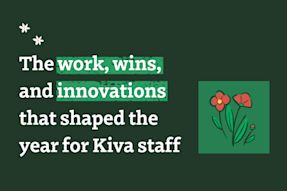This post was written by Gabriela Aleman, Kiva's Impact Investments Fellow for Latin America, during her travels.
Something that I’m so amazed by is how food can illustrate changes experienced by communities over generations. Traveling around the world, or even around the corner to a new restaurant, allows you to taste culture through a shared interest. By using food as my critical lens, I learned about the impact of climate change on global farming.
As a Fellow, you have the opportunity to visit the areas where Kiva heavily invests to promote financial inclusion to the most underserved communities. Here is where I observed the changes to a specific economic indicator, personal income, as a result of a rise in food prices. I wanted to understand how something such as the fall in the global price of coffee would affect individuals like our borrowers. Through food, we can sow the seeds of our future.
In northern Nicaragua, monoculture is the main source of income for many small towns. As the country’s agrarian heartland, there are vast fields that produce crops for consumption and export. Monocrops include foods such as coffee, corn, cabbage and beans. At ~10% of Nicaragua’s total gross domestic product (GDP), agriculture is the industry with one of the largest contributions to the economy.
On a smaller degree, each harvest is the largest yearly source of income for our borrowers. Harvest cycles are the way in which our loans are structured by our Field Partners, with loan terms long enough to cover the cost of seeds for inputs and repayment as a lump sum after the harvest. Unfortunately, this year did not yield the same amount of crop per acre and it is reflected in the price rise of consumer staples.

For many of our borrowers who are farmers, they store a portion of their crops for year-round consumption and sell off the rest to pay off their loans and other bills. Borrowers that prepare food for sale monitor the prices of staples such as corn to use their loans to buy in bulk. For both of these groups, they have modified their habits in light of price changes. When asking about their diet, they mentioned that they buy more meat because beans are too expensive. This takes a toll on nutrition, in a country where obesity is on the rise.

Unfortunately, poverty and obesity tend to be directly correlated.
How do these borrowers adapt? While conducting over 40 surveys on the impact of climate change on their lives, I was able to witness the creativity of their resilience. I asked questions like, “Has the price of food increased over the past few years?” and “What percentage of your loan portfolio is directly impacted by climate change?” Their lengthy answers detailed stories, ideas, and solutions.
As the price of staple crops began to rise, the individuals I interviewed begun to experiment with more climate-resistance crops (such as taro) and prepare foods in different ways (like pickling foods). While collecting these surveys, I also had the opportunity to collect these recipes. I find these beautiful, because they are proof of local adaptation.

Vegetable Nachos
2 cup of thinly sliced plantains
2 cup of thinly sliced taro
1 cup of shredded cabbage
¼ cup of mayonnaise
Juice from one lemon
1. Wash and peel the plantains and tarot. With a mandolin or sharp knife, slice both very thinly (think of chips) and lay on a baking sheet. Drizzle your preferred type of vegetable oil lightly over the chips before putting them in the oven. Bake at 350F until crispy (20-30 minutes).
2. Wash, dry, then cut the cabbage. In a separate cup, squeeze the juice of one lemon with the mayonnaise and whisk. Pour sauce over the cabbage until completely covered, toss to coat and let sit.
3. Place vegetable crisps at the bottom of a large dish, with the cabbage on top. Serve to share!

Pickled Plantains
4 green plantains
1 cup of olive oil or vegetable oil
2 cloves of garlic
1 onion
1 green pepper
1/3 cup of vinegar
1. Cut plantains in cubes. Place them in a large pot and cover with water that is a few finger lengths higher than the plantains.
2. Boil for 10 minutes, then let the mixture cool.
3. In a separate pot, place oil to heat. Afterward, add onion, green pepper, vinegar, salt and pepper. (Optional: add garlic once the onion is translucent). Cook on medium heat for about 6-10 minutes.
4. Seal the mixture in air-proof jars, place in the fridge to let marinate. Store in a cool place.
5. When desired, open a jar and use for any type of salad, condiment, or appetizer.
The Kiva community is exposed to climate change because of its geographical span. It’s also exposed to a multitude of peoples, cultures, and flavors. By using food to link borrowers and lenders, we can bridge the gap to find greater sources of collaboration.
PREVIOUS ARTICLE
Letters from an Intern: Nicole Morris engages with the Kiva community →NEXT ARTICLE
International Women’s Day is just business as usual for Kiva →














